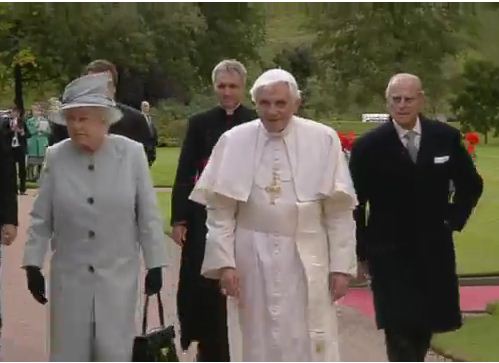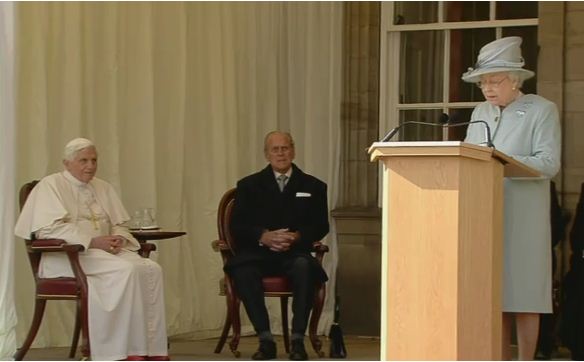|
Papal visit 460 years after the Reformation
Pope Benedict XVI made the first state visit of a Pope to the United Kingdom since the Refomation in the 16th Century and 460 years after John Knox led the Reformation in Scotland. The visit is not free of controversy.
See foot of article for pictures
 FOUR hundred and fifty years after John Knox and the Lords of the Congregation launched the Reformation in Scotland a Roman Catholic Pope has made his first state visit to these shores. FOUR hundred and fifty years after John Knox and the Lords of the Congregation launched the Reformation in Scotland a Roman Catholic Pope has made his first state visit to these shores.
In a significant departure from normal arrangements and viewed as an important mark of respect the Pontiff was met by Prince Phillip, Duke of Edinburgh at Edinburgh Airport.
The present visit of Pope Benedict XVI follows a visit made by his predecessor Pope John Paul, but there are important differences between these two occasions. While the previous Pope’s visit was pastoral this visit is a formal state occasion.
Pope Benedict has been officially invited by the Queen into a Britain which saw an earlier monarch and an ancestor of the Queen issue a declaration of independence from the Pope of that day. In 1534AD King Henry VIII set himself up as head of the Church of England – a position still held by the current Queen.
The run-up to the Pope’s visit has been marked by public and widespread criticism of recently-uncovered and widespread incidents of child abuse perpetrated by Roman Catholic clergy. The Pope has been accused of turning a blind eye to these serious cases in order to protect the reputation of the Church.
C of S Moderator not present
The Pope’s plane landed in Edinburgh on the morning of Thursday, 16 September, 2010. He was then driven to Holyrood Palace in the Scottish capital where he was officially met and welcomed by the Queen. She then introduced him to a line-up of official representatives including, the Scottish First Minister, the Archbishop of Canterbury and the UK’s Deputy Prime Minister. The Moderator of the Church of Scotland was not in the line up due to a 'mix up'. The BBC commentary described the Archbishop of Canterbury, Rowan Williams as the head of the Church of Scotland.
 A speech of welcome was given by the Queen, in which she expressed the hope that the visit would “provide an opportunity to deepen the relationship between the Roman Catholic church and the Established Church of England and the Church of Scotland.” A speech of welcome was given by the Queen, in which she expressed the hope that the visit would “provide an opportunity to deepen the relationship between the Roman Catholic church and the Established Church of England and the Church of Scotland.”
The Monarch also thanked the Vatican for its role in ending the sectarian violence in Northern Ireland.
Aggressive Secularism
In his response and address the Pope included reference to what he sees as “aggressive forms of secularism” which are attacking traditional values. This has been a theme of many of the Pope's public statements and it is perhaps significant that the Pontiff addressed this issue right at the start of his 4-day visit to the UK.
In 1707 Scotland legally united with England and Wales to form the United Kingdom of Great Britain via an Act of Union with a single monarch and a London-based government. Paving the way for this historic event was the Act of Settlement in 1701 which stipulated that every monarch would be of the Protestant faith and married to a Protestant.
From 1707 until the formation of a new Scottish Parliament in 1999, the annual Church of Scotland General Assembly was the nearest thing Scotland had to a national parliament.
The last Catholic uprising in Scotland was the Battle of Culloden in 1746 on the outskirts of Inverness in which the ‘Young Pretender’ Prince Charles Edward Stuart and those Highland clans who supported him were defeated by government troops. Prince Charles escaped and subsequently fled to France.
At the time of the Reformation, John Knox and his companions had no desire to see two churches in Scotland. Rather he sought to reform the church of his day. In drawing up a Scot’s Confession the starting point was not institutional reform but the setting out of beliefs.
It is on this point of Biblical fidelity that evangelical believers remain critical – highly in some cases – of the Roman Catholic Church. [See article 'But the Bible does not say'.]
A 60-strong delegation of the Free Presbyterian Church in Ireland travelled to Scotland to make protest about the Pope’s visit. In advance of the visit, the Rev. Ian Paisley said that the protest would be peaceful: “We will be having a meeting in the place where the church of Scotland was formed and was presided over by John Knox. That building will be at our disposal. “We will unfurl a banner and have a public meeeting outside that building in the Grassmarket. “What we're doing, we're making a legitimate protest about something that is entirely wrong and I am looking at myself as a person who is prepared to champion those who have been very, very badly treated by these priests of Rome.”
Many would argue that one of the underlying factors in the cases of child abuse in the Roman Catholic Church is the Church’s insistence on celibacy amongst it’s clergy; a practice which the Bible describes as ‘the doctrine of demons’ (1 Tim 4:1-4).
Following the reception in Edinburgh which culminated in a motorised procession through the centre of Edinburgh the Pope was to have lunch with the menu including the traditional Scottish dish of 'haggis, neaps and tatties'. By the time he left Holyrood he was wearing a scarf of a newly-created St. Ninian's Tartan and gifted to him by the Roman Catholic Church in Scotland.
Later in the day he was go on to Glasgow and hold an open-air service (Mass) in Scotland’s second city’s Bellahouston Park.
After receive the Pope, the Queen returned to her traditional late Summer/Autumn retreat at Balmoral Castle in 'Royal Deeside'.
Pope Benedict’s predecessor Pope John Paul II made a hugely-popular pastoral visit to Scotland in 1982. However the (Protestant) Church of Scotland – though since its formation racked and much-weakened by schism maintains its position as the national church. The Kirk as it is affectionately known, stands of the brink of yet another major split over the subject of human sexuality.
Meanwhile the Roman Catholic Church in general and the present Pope in particular speak out strongly in defence of traditional views of sexuality and marriage.
Footnotes:
A commemoration service marking the 460th anniversary of the historic events of 1560AD in Scotland is scheduled to be held in Edinburgh's St. Giles Cathedral later this year.
See 'The Reformation: they think it's all over; it is now'
For an overview of Scotland written around pictures of Edinburgh earlier this year (May 2010) see:
A Snapshot of Scotland at Election Time
|
Christians Together, 16/09/2010
|
|
|
|